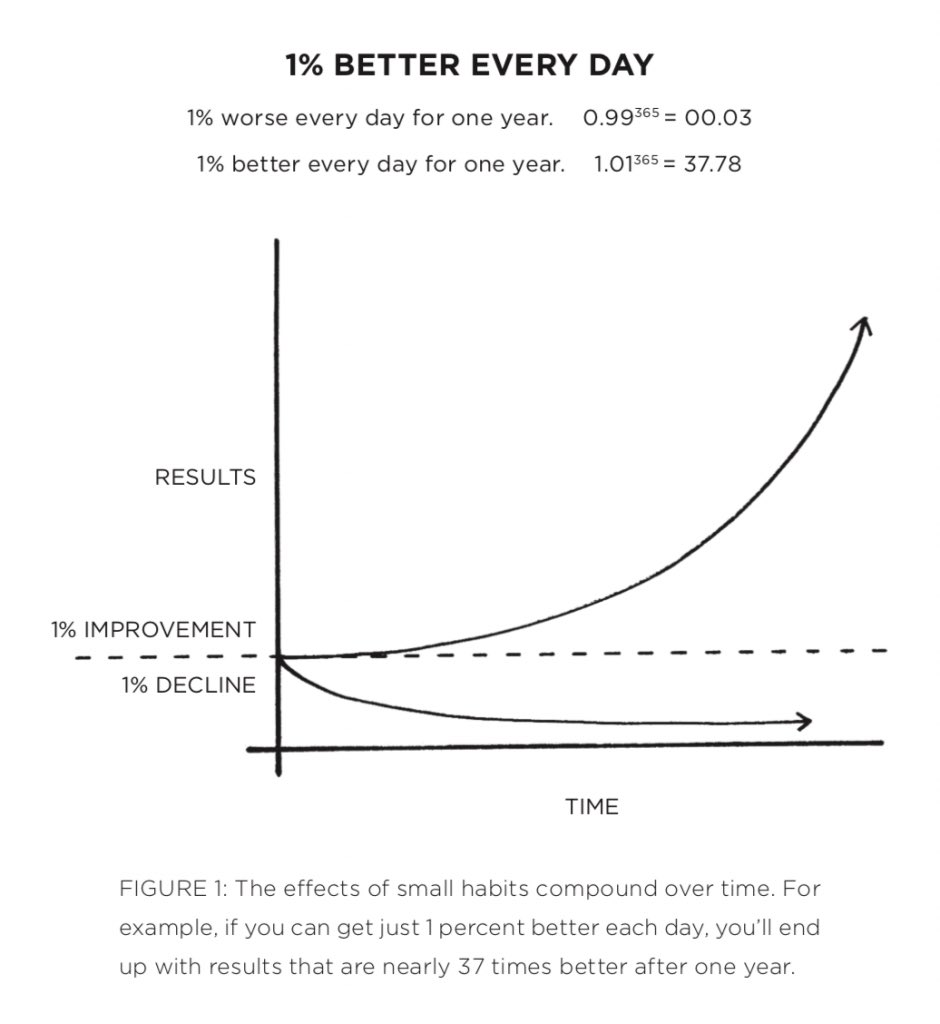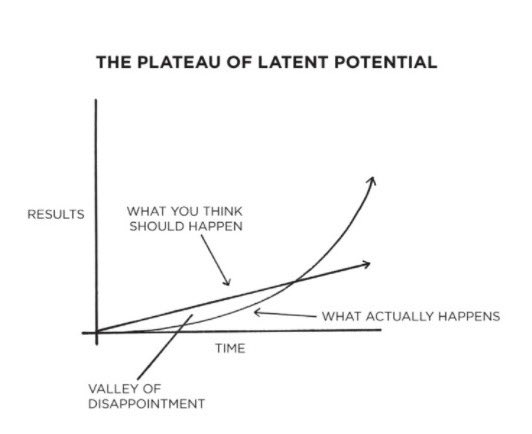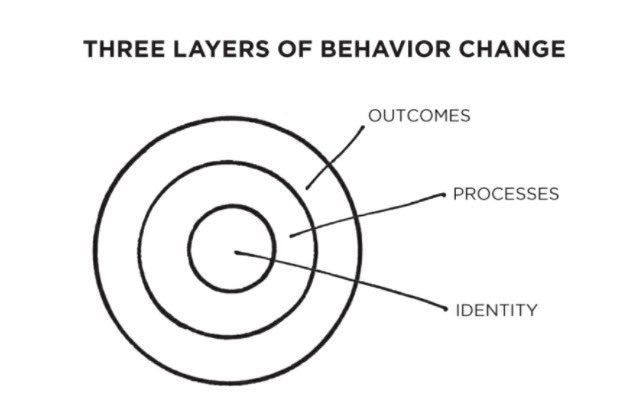
My daughter has just finished reading 'Atomic Habits' and I have started to observe a few changes in her behavior, most notably, she is now better prepared for Sat 7AM swim session. Her swim bag and costume are right by her bedside the night before. I was impressed by this tiny
change so asked her to summarise the book for me. I found it very impactful for behavior change and building new habits so sharing here
@dmuthuk @unseenvalue @nishkumar1977 @connectgurmeet @ishmohit1 if you find it useful, kindly like or RT so that it reaches the wider audience.
@dmuthuk @unseenvalue @nishkumar1977 @connectgurmeet @ishmohit1 if you find it useful, kindly like or RT so that it reaches the wider audience.
1. A large portion of our daily actions are influenced by our automatic habits, habits that have been formed through repetition over the course of our entire life. There are healthy and productive habits that serve us and negative ones that work against us.
2. We are what we repeatedly do and the quality of our lives often depends on the quality of our habits.
Lesson 1: Tiny changes lead to big improvements
“Atomic habits” is all about showing how small and seemingly unimportant changes and adjustments can lead to a massive
Lesson 1: Tiny changes lead to big improvements
“Atomic habits” is all about showing how small and seemingly unimportant changes and adjustments can lead to a massive
3. transformation. If you make a tiny 1% improvement to something on a daily basis in the course of just one year, you end up being 37 times better...37 times better health, 37 times better finances or relationships, even a fraction of that will significantly transform your life 

4. We often dismiss small changes because they don’t seem to matter much in the moment. If you save a little money today, you are still not a millionaire. If you go to the gym 3 days in a row, you are still out of shape. We make a few changes, but the results never seem to come
5. quickly so we slide back to the previous routine.
When we repeat 1% improvement, day after day, our small choices compound into significant improvements.
Success is the product of daily habits, not once-in-a-lifetime transformations.
When we repeat 1% improvement, day after day, our small choices compound into significant improvements.
Success is the product of daily habits, not once-in-a-lifetime transformations.
6. Kaizen Approach:
After the 2nd world war, Japan started using a philosophy called ‘Kaizen’ that seeks to achieve small, incremental improvements in processes in order to improve efficiency and quality in personal or professional life.
These small incremental changes add
After the 2nd world war, Japan started using a philosophy called ‘Kaizen’ that seeks to achieve small, incremental improvements in processes in order to improve efficiency and quality in personal or professional life.
These small incremental changes add
7. up to substantial changes over the longer term.
Essence to building a new habit or bringing in improvement in any areas in your personal/professional life is to
‘Start with the smallest and practice the easiest’.
Essence to building a new habit or bringing in improvement in any areas in your personal/professional life is to
‘Start with the smallest and practice the easiest’.
8. Lesson 2: The Plateau of Latent Potential
We now know that all big things come from small beginnings and the seed of every habit is a single tiny decision.
If this is so simple, how is it that a lot of people find it difficult to build a habit? Answer lies in the fact that
We now know that all big things come from small beginnings and the seed of every habit is a single tiny decision.
If this is so simple, how is it that a lot of people find it difficult to build a habit? Answer lies in the fact that

9. we often expect linear progress, or at least we hope it will come quickly. However, in reality, the key aspect of any compounding process is that the outcomes are delayed. This leads to an initial valley of disappointment, where we don't feel like we're making progress,
10. as the results don't follow the linear trajectory that we wanted, but as we can see from the graph, it does take time to build a habit to allow the compounding of self-improvements to take hold and give us amazing results over time.
11. Remember the stone cutter story? Stone cutter hammering away at his rock, perhaps, a hundred times without any success. Yet at the hundred and first blow, it will split in two. It was not the last blow that did it, but all that had gone before.
12. When you finally break through the Plateau of Latent Potential, people will call it an overnight success but in reality, it is the cycle of endless refinement and continuous improvements
Lesson 3: Forget about the goal & focus on the system instead
Goals are the results you
Lesson 3: Forget about the goal & focus on the system instead
Goals are the results you
13. want to achieve while systems are about the processes that lead to those results.
The main problem with goal driven behavior is that it tends to ignore the process of getting there and just concentrates on getting the final outcome.
If you want 6 pack abs, concentrate on
The main problem with goal driven behavior is that it tends to ignore the process of getting there and just concentrates on getting the final outcome.
If you want 6 pack abs, concentrate on
14. improving your dietary habits and continuous improvement in the gym rather than being obsessed with the goal of 6 pack abs.
Winners and losers have the same goals; every Olympian wants to win a gold medal so it can’t be the goal that actually differentiates people.
Winners and losers have the same goals; every Olympian wants to win a gold medal so it can’t be the goal that actually differentiates people.
15. Goal is always there but it is only a system of continuous small improvements over a long period that leads to the desired outcome.
Lesson 4: Transition from outcome-based habits to identity-based habits
“There are three layers of behavior change:
Lesson 4: Transition from outcome-based habits to identity-based habits
“There are three layers of behavior change:
16.
1. a change in your outcomes 2. a change in your processes or 3. a change in your identity.”
“Outcomes are about what you get. Processes are about what you do. Identity is about what you believe.”
With outcome based habits, focus is on what you want to achieve.
1. a change in your outcomes 2. a change in your processes or 3. a change in your identity.”
“Outcomes are about what you get. Processes are about what you do. Identity is about what you believe.”
With outcome based habits, focus is on what you want to achieve.

17. With identity based habit, focus is on who you wish to become.
You may start a habit because of motivation, but the only reason you’ll stick with one is when it becomes part of your identity.
Ultimate form of intrinsic motivation is when a habit becomes part of our identity
You may start a habit because of motivation, but the only reason you’ll stick with one is when it becomes part of your identity.
Ultimate form of intrinsic motivation is when a habit becomes part of our identity
18. True behavior change is identity change.
When your behavior and identity are fully aligned, you are no longer pursuing behavior change. You are simply acting like the type of person you already believe yourself to be.
When your behavior and identity are fully aligned, you are no longer pursuing behavior change. You are simply acting like the type of person you already believe yourself to be.
19. “The most effective way to change your habits is to focus not on what you want to achieve, but on who you wish to become.”
20. If you plan to run a marathon, you goal is not to run 26.2 miles but to become a runner, and being a runner is who you are, that’s your identity.
20. If you plan to run a marathon, you goal is not to run 26.2 miles but to become a runner, and being a runner is who you are, that’s your identity.
21. Similarly, it’s not about reading a book but becoming a reader.
Every time you write a page, you are a writer.
Every time you start a workout, you are an athlete.
Becoming the best version of yourself requires you to start with the kind of person you want to become and
Every time you write a page, you are a writer.
Every time you start a workout, you are an athlete.
Becoming the best version of yourself requires you to start with the kind of person you want to become and
22. build small habits that reinforce that identity.
Lesson 5: How to build good habits & break bad habits:
The process of building a good habit can be divided into four steps:
1. Cue : Make it obvious
Cue triggers the brain to initiate an action, it is a bit of
Lesson 5: How to build good habits & break bad habits:
The process of building a good habit can be divided into four steps:
1. Cue : Make it obvious
Cue triggers the brain to initiate an action, it is a bit of
23. information that predicts a reward and leads to a craving.
2. Craving: Make it attractive
Craving is the motivational force behind every habit, without craving for a change - we have no reason to act
3. Response: Make it Easy
Response is the action or habit that we perform.
2. Craving: Make it attractive
Craving is the motivational force behind every habit, without craving for a change - we have no reason to act
3. Response: Make it Easy
Response is the action or habit that we perform.
24.
4. Reward: Make it satisfying
How to Break a Bad Habit:
Inversion of
. 1st Law (Cue): Make it Invisible.
· 2nd Law (Craving): Make it Unattractive.
· 3rd Law (Response): Make it Difficult.
· 4th Law (Reward): Make it Unsatisfying.
4. Reward: Make it satisfying
How to Break a Bad Habit:
Inversion of
. 1st Law (Cue): Make it Invisible.
· 2nd Law (Craving): Make it Unattractive.
· 3rd Law (Response): Make it Difficult.
· 4th Law (Reward): Make it Unsatisfying.
25. Let’s look at an example: You are sitting idle at home, that feeling of boredom is your Cue. You feel the need to entertain yourself, that’s your craving. You take out your phone to check social media or watch Netflix, that’s your response and your reward is that little
26. entertainment you get by watching social media/Netflix.
If you repeat this behaviour enough, watching Netflix or social media will become your natural response to boredom
All four steps are required to build any habit. Eliminate the cue and habit will never start.
If you repeat this behaviour enough, watching Netflix or social media will become your natural response to boredom
All four steps are required to build any habit. Eliminate the cue and habit will never start.
27. Reduce the craving and you won’t experience enough motivation to act. Make the behaviors difficult and you won’t be able to do it, and if the reward fails to satisfy your desire, then you’ll have no reason to do it again
28. One of the most practical ways to eliminate a bad habit is to reduce exposure to the cue that caused it.
- If you can’t focus on work, leave your phone in another room for a few hours
- If you are wasting too much time watching television, move the TV out of your bedroom
- If you can’t focus on work, leave your phone in another room for a few hours
- If you are wasting too much time watching television, move the TV out of your bedroom
29.
- If you are eating chocolate & other sweets food at home, don’t sweets at home.
This way you will make the cue invisible Without Cue, there will be no craving, and getting out of the home to buy chocolates makes it unattractive and mostly unsatisfying.
- If you are eating chocolate & other sweets food at home, don’t sweets at home.
This way you will make the cue invisible Without Cue, there will be no craving, and getting out of the home to buy chocolates makes it unattractive and mostly unsatisfying.
30. Likewise, in order to create a good habit, make the cues of your good habits obvious and easy.
- If you want to go to the gym in the morning, prepare your clothes and shoes the night before and keep them next to your bed.
- If you want to go to the gym in the morning, prepare your clothes and shoes the night before and keep them next to your bed.
31. Remember that a habit is a behavior that has been repeated enough times to become automatic.
In order to create a new habit, we can take exercising, it’s better to go 3 times a week to the gym for a 10 minutes exercise than to go only once for a one hour exercise.
In order to create a new habit, we can take exercising, it’s better to go 3 times a week to the gym for a 10 minutes exercise than to go only once for a one hour exercise.
32. Lesson 6: “Human behavior follows the Law of Least Effort.”
We will naturally gravitate toward the option that requires the least amount of work. Reduce the friction associated with good behaviors. When friction is low, habits are easy.
We will naturally gravitate toward the option that requires the least amount of work. Reduce the friction associated with good behaviors. When friction is low, habits are easy.
33. Increase the friction associated with bad behaviours. When friction is high, habits are difficult.
Lesson 7: How to Stop Procrastinating by Using the Two-Minute Rule
‘When you start a new habit, it should take less than two minutes to do.’
Lesson 7: How to Stop Procrastinating by Using the Two-Minute Rule
‘When you start a new habit, it should take less than two minutes to do.’
34. Idea is to standardize before you optimize.
Any habit can be scaled down to 2 minute rule.
- ‘Read before bed each night’ becomes ‘read one page’
- ‘Run 3 miles’ becomes ‘tie my running shoes’
Any habit can be scaled down to 2 minute rule.
- ‘Read before bed each night’ becomes ‘read one page’
- ‘Run 3 miles’ becomes ‘tie my running shoes’
- ‘Exercising in the gym’ becomes ‘wear gym cloths and step outside the house’
The idea is to make your habits as easy as possible.
--End of Thread--
The idea is to make your habits as easy as possible.
--End of Thread--
• • •
Missing some Tweet in this thread? You can try to
force a refresh




